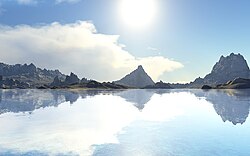Terragen
 Terragen 2.0.1.1 | |
| Original author(s) | Matt Fairclough |
|---|---|
| Developer(s) | Planetside Software |
| Stable release | 4.5.56
/ January 1, 2021 |
| Written in | C++ |
| Operating system | Windows, Mac OS X |
| Type | 3D computer graphics |
| License | Commercial, freeware |
| Website | planetside |
Terragen is a scenery generator program for Microsoft Windows and Mac OS X developed and published by Planetside Software. It can be used to create renderings and animations of landscapes.
History
[edit]
| Original author(s) | Matt Fairclough |
|---|---|
| Developer(s) | Planetside Software |
| Stable release | 0.9.43
/ September 7, 2005 |
| Preview release | 1.9.99.1
/ July 31, 2008 |
| Operating system | Microsoft Windows, Mac OS X |
| Type | 3D computer graphics |
| License | Commercial, Freeware |
| Website | Terragen Classic for Windows Terragen Classic for Mac |
Released in stages (tech preview and beta) to a participating community, Terragen 2 was released to pre-purchasers on 2 April 2009.[1][2] Terragen 2 is offered in feature limited freeware and full-featured commercial licenses.
Planetside Software released the first public version of Terragen 2 after more than three years of development of both the core technologies and the program itself.[3][4] Since then there have been several released updates to both licenses of the software along the development cycle with a series of technology previews and a beta release. The "final" build was released on April 23, 2009, and more updates, including feature modules, are expected to be released later.[5]
Planetside released Terragen 3 in August 2013.[6] Version 3.1 was released in February 2014. Version 4 was released in 2016.


Terragen Classic
[edit]Terragen Classic is popular among amateur artists, which can be attributed to it being freeware, its intuitive interface, and its capability to create photorealistic landscapes when used skillfully. It can also use DEM (digital elevation model) files, and other graphic surface maps for rendering.
A commercial version of the software is also available and is capable of creating larger terrains, renders with higher image resolution, larger terrain files, and better post-render anti-aliasing than the freeware version.
The terrain is generated from a two-dimensional heightmap. The program contains facilities for importing and exporting heightmaps to images, for use in other programs.
Use in media
[edit]Rendering software contributed by PlanetSide proprietor Matt Fairclough was used by Digital Domain for effects in Star Trek Nemesis. Terragen Classic was used in The Golden Compass, the 2006 remake of The Wicker Man, games, and many TV commercials.[7][8][9]
An image from what is now known as Terragen Classic appeared on the April 16, 2001, cover of Newsweek, and Terragen was used for animations in Brandy Norwood's "What About Us?" music video. The classic version was also used by numerous artists, such as Joan Fontcuberta ("Orogenesis" series),[10] and the French photographer Mathieu Bernard-Reymond ("Vous êtes ici" series and "Pôle" series). Terragen Classic was used to create skyboxes for 3D video games such as Serious Sam.
The software was used by Devastudios to create the mountainous scenery in the intro used by Paramount Pictures for its centennial anniversary in 2012, alongside Autodesk Maya, with Mission: Impossible – Ghost Protocol in 2011, which would be carried on for Paramount Players, Paramount Television Studios and Paramount+.[11] Devastudios also used the software for the sky and clouds in the 2021 and 2023 Warner Bros. Pictures logos with Locked Down and Wonka, respectively, alongside the Academy Color Encoding System (ACES) and Adobe Substance 3D Painter for the latter, which would later be carried on for Warner Bros. Television, New Line Cinema and Warner Bros. Pictures Animation.
See also
[edit]References
[edit]- ^ Planetside Forums
- ^ Pre-purchasers get release early[permanent dead link]
- ^ M. Larsson; M. Wrenninge; Roble (August 2004). "Inter-frame caching for high quality terrain rendering". ACM SIGGRAPH 2004 Sketches on - SIGGRAPH '04. p. 9. doi:10.1145/1186223.1186235. ISBN 1-58113-896-2. S2CID 230003.
- ^ Fairclough, Matt; M. Wrenninge; M. Larsson (August 2004). "Robust rendering of high resolution terrain: Copyright restrictions prevent ACM from providing the full text for this work". ACM SIGGRAPH 2004 Sketches on - SIGGRAPH '04. p. 10. doi:10.1145/1186223.1186236. ISBN 1-58113-896-2. S2CID 23197912.
- ^ Beta Release announcement
- ^ "Terragen 3". Planetside Software. Retrieved 24 September 2014.
- ^ Terragen 2, Planetside.co.uk
- ^ "About us: Matt Fairclough, Proprietor and Lead Developer". Planetside Software.
From 2000 to 2003 Matt was also a Technical Director at Digital Domain in Venice, California. He is credited in The Time Machine, Star Trek: Nemesis, and The Day After Tomorrow. Matt initiated the development of Digital Domain's proprietary terrain renderer which was used in the films Stealth, Flags of Our Fathers, Letters From Iwo Jima and other films and TV commercials. Much of its core technology went on to become Planetside Software's Terragen 2.
- ^ "Planetside Home: Change the landscape with Terragen". Planetside Software.
Terragen has been used to create visual effects for many films including The Golden Compass and The Wicker Man, dozens of games and countless TV commercials
- ^ Joan Fontcuberta. Archived 2008-04-03 at the Wayback Machine New York: International Center of Photography. Retrieved 10 July 2008.
- ^ "Paramount's 100th Anniversary Logo Created With Terragen". Planetside Software. 3 October 2016. Retrieved 2020-11-20.
